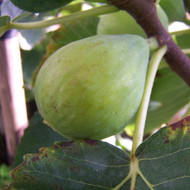Figs are probably one of the earliest fruit to have been cultivated. There are traces of fig farms in Jordan from 9000BC. Like many fruit, they are originally from the area around Iran and Iraq. They were a favourite fruit of both the Greeks and the Romans, and the Romans imported the fruit into Britain. However, when you think of figs, you probably imagine Mediterranean scenery, scorching sunshine and dry stony soils. A fruit for growing in a warmer climate than we in the U.K. have most summers. A taste of foreign holiday, much like that lemon liquor that tasted fantastic at the time but the bottle of duty free now lurks at the back of the drinks cupboard.
Not so. Figs have been grown in this country since 1552, when they were planted at Lambeth Palace by Cardinal Pole. There were commercial fig farms in the U.K. in the 1950’s. Whilst figs are seen as the preserve of stately homes with heated glasshouses, with a little care and attention it is possible for most gardeners to enjoy the delights of a homegrown fig.
Soil and site.
Figs thrive in poor soils. They love a dry, chalky site in full sun, where the excellent drainage and lack of nutrients will promote the best fruiting. Give a fig a rich soil with plenty of organic matter and you will get huge amounts of luxuriant growth, but very little fruit. Even if you do not naturally have such soil in your garden, there are a couple of easy ways to recreate it.
Probably the best known method is to create a pit. Dig a hole approx. 60cm wide and deep. Line the sides with old paving slabs and place a thick layer of rubble or stones at the bottom. The idea isn’t to to completely stop roots from escaping - so a few gaps are fine - merely to impede the root system. Fine fibrous roots which take up water and nutrients will still be able to get through, but not the large tap roots which encourage growth. The good news is that, for once, a garden on very heavy clay can actually be an advantage - it will naturally restrict root development. The only issue is that drainage will probably be poor, so don’t skimp on the layer of rubble at the bottom of the planting hole.
Another way to keep growth under control is to grow in a pot. Figs make fantastic potted trees for a sunny patio, where the lush foliage is attractive in its own right. Use a soil based compost such as John Innes No 3, and make sure you put plenty of crocks at the bottom. As with all containers, it’s a very good idea to use pot feet or half bricks to raise the pot, especially over winter. Most figs are hardy enough, but they will resent spending the winter months with waterlogged roots. If you are growing in a container, feed with a high potash fertiliser (such as tomato feed) over the summer months, and keep the compost just moist. Whilst figs tolerate dry conditions, they will shed their fruit if they get too dry.
Figs also enjoy the dry conditions at the base of a sunny wall, and so make an excellent choice for trading as a fan. They will need some support, so best to put in some horizontal wires about 45cm apart.
Pruning.
The best time to prune is in April, before growth has properly started. In the first couple of years, the aim is to produce a nice open framework of branches. Clear out any growth in the centre of the plant, and don’t be afraid to cut back any long leggy growth. Figs produce most of their fruit on one year old wood, so once a good structure is in place, simply prune to leave 20cm or so of last year’s growth - the tiny fig lets will just be visible between the leaf nodes.
Fan trading is pretty much as for plum trees, except for the timing. Tie in as many shoots as you can, remembering that pruning will encourage dormant buds to break and grow in the direction they are pointing. Once a fig has outgrown its position, select a couple of the oldest main stems and prune them back hard - this will encourage fresh productive growth.
Figs will naturally try and crop twice every year - one crop which develops and ripens over the summer to crop in early autumn, and another which over winters and ripens over spring and early summer. In the U.K. our winters are too cold and long for this second crop to ever develop, and trying to do so only weakens the plant. In October it’s very important to remove all fruits which are larger than your little fingernail. Don’t be greedy, these fruit will never ripen and they will stop the following years summer crop from developing properly.
Varieties.
Bornholm's Diamant. A wonderful fig originating in Denmark. Though to be a close relative of the much better known variety 'Brown Turkey', with whom it shares its hardiness and reliability, but the quality of the fruit is even better. Buy Now
Brown Turkey. The most widely grown fig in the U.K., and for good reason. One of the earliest to ripen, so produces a good crop even in a poor summer. Heavy crops of dark brown sweet fruit. Buy now
Madeleine de Deux Saisons. An outdoor variety of medium upright growth (4m in height) and excellent cold hardiness make this an ideal choice for outdoor cultivation for most of the UK, being one of the earliest figs to crop. Buy Now
Osborne's Prolific. An excellent fig, the tree is suited to pot culture and is an abundant bearer. The fruit is dark mahogany in colour fading to pale brown at the neck, and speckled with grey dots. The flesh has a rich syrupy juice and an excellent flavour. Buy now
Peters Honey. Probably the sweetest fig you can buy - each large green yellow fruit is an absolute treat. The downside is that it does need a very warm site to do well, but is an excellent choice for growing in a greenhouse. Buy now

